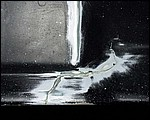 |
Here the damage assessment begins, after removing the
spoiler from the car, I begin with a 150 grit sandpaper to scrape the top
layer of paint and primer to reveal the crack on the front of the spoiler..
its bad..
|
 |
The crack continues up the euro license plate edge, a single continual
crack moving all the way to the stop of the spoiler
|
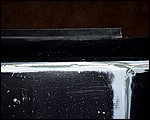 |
Once at the top, the top ridge on both side of the
joint have cracked along the edge, fiberglass does not bend very well under
stress and this chuck of mud is turning into a nightmare of damage on my
spoiler.
|
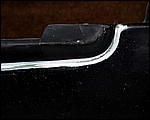 |
the crack finally stops (after hours of sanding, I though I as going to
have to toss the spoiler, but it end on the left side (driver side) of the
tip edge of the spoiler.
|
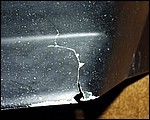 |
the corner shows secondary damage, a nasty crack, and
the bottom angle is totally missing...
|
 |
here is a complete picture of the damage found...all white lines are
sanded areas to the fiberglass to expose the areas that will need to be
cared for.
|
 |
flipping the spoiler on the reverse side, I start
working the inside of the fiberglass, sanding it all down revealing the
depths of the cracks, and ensuring the best possible "traction" for the new
fiberglass Bondo I am about to use to fix it. I used a premixed called
Fiberglass Bondo, it is basically a putty of sort that is used for spoiler
and fiberglass work on cars and boat, you scoop a lump of it, trickle a
little hardener on it, mix and lay on the prepared surface, 5 minutes later
its Hot and hard in place as the picture shows, it took 3 lay downs of
fiberglass bondo to cover all the areas. I felt it required a thick layer so
I did lay about 1/8" thick bondo on the back to hopefully support the damage
from re-opening itself.
|
 |
After letting the fiberglass bondo dry up 24 hours (some people work
fiberglass while still warm, I like to work it cold, as the friction of sand
paper heats it up as is, and if still warm the fiberglass bondo can become
clumpy and detach itself from the fiberglass. here we see I lay a thin layer
on the front of the spoiler to a) fill the gap b) to create a layer to hide
the cracks.
|
 |
here is a close up of the work 24 hrs after it dried.
|
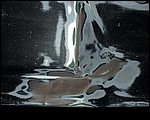 |
using 150 sandpaper I sand down lumps and edges, then switch to 200 to
make it smoother. until the finger tips cannot feel the difference between
the actual spoiler and the new material sur imposed on it.
|
 |
here we see the corner after 200 grit has gone past
it.
|
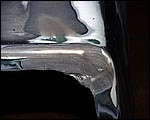 |
here we see the reconstructed corner that was snapped off...
|
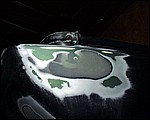 |
while the main breaks dry some more... I start
scrutinizing the rest of the spoiler and find some holes on the top corners
|
 |
some minor cracks on the top right side
|
 |
a nice hole (was plugged with putty) that needed some
attention
|
 |
Here the top ridge is done... things are starting to take shape.
|
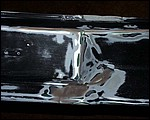 |
Finally after it is done, this is what the front of
the spoiler looks like....
|
 |
all area's fixed, I wet sand the complete spoiler with 400 grit to clean
it all up, note that there is under layer of paint remaining, it is NOT
required to sand the fiberglass back to its original unpainted state to fix
it.
|
 |
right side after 400 wet sand
|
 |
here the spoiler dries after I wash it with paint thinner to clean out
all traces of grease and dust from it. soon the primer is going on it.
|
 |
fiberglass primer contains a small amount of
rubberized compound, this is a good thing for a spoiler, it permits to grip
a little more unto the fiberglass, here the picture shows the spoiler
painted with 4 layers of primer, work it in light layers to have good
coverage, let sit for 10 minutes between each coat the almost dry primer
coat will be sticky and help in bounding the next layer unto the spoiler...
Then Let dry 1 hour.
|
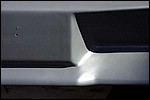 |
a close up of the primed previously broken front license plate area.
|
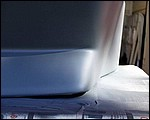 |
close up of the corner that was destroyed and
cracked... now doesn't that look good?
|
 |
once the four coats of primer are dry, I use similar rubberized paint
for bumpers, black is my choice of color (and a reason why I used gray
primer) 4 coats of paint once again.. in layers, this time 20 minutes
apart.. paint take a little longer to become tacky compared to primer that
is.
|
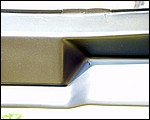 |
close up of the repainted and finished front euro
license plate area
|
 |
and the corner... its all good now. reinstall the spoiler... enjoy!, I
know I did... the complete time frame this took to fix, was 6 days...
|





